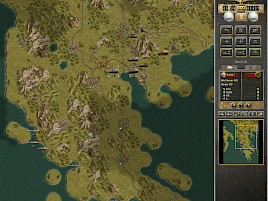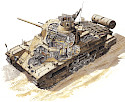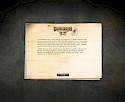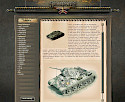Panzer Corps Review
Let's see if I can do this review without mentioning That Game. No, not that one, That One.
Panzer Corps is a hex-based strategy game, incorporating 26 scenarios into a branching campaign spanning 1939 to 1945. You control the Germans as they romp (or not) across Poland, Norway, France, Russia, Italy, and if you do well enough, certain other countries. Wink wink. You're given a range of units that expands as the game progresses, with 400 different units thankfully divided up into 19 classes, and each unit has 20 different attributes. These units fight across 17 different terrain types, through rain, snow, mud, and frost.
As a reimagining of a classic, you can't help but notice all the resemblances. The overall design aesthetic, the screen layout, identical function buttons, it's there right out in the open. It's rather surprising how quickly the evocation of an old design restores old reflexes, and immediately you're flicking your mouse right, to the sidebar, and clicking away...despite the fact you've never played Panzer Corps before (assuming you have prior experience with That Game). You can expand the sidebar to include a unit list, stat panel and reserve list, although with all three turned on, the sidebar then takes up almost half of the screen.
The faux-military design permeates the whole game; officer epaulettes represent difficulty levels, gold-trimmed option sliders, you never come up against a bare menu. The look of the game is complete and polished, and this extends to the detailed units and terrain. Unit models are easy to differentiate, and their strength and status are always visible. Icons are clear and unambiguous, and you're always provided with pop-ups in case your brain strokes off. A lovely little addition are explosions matching the damage done in combat, with sprays of earth for misses and unit-enveloping fiery blooms for complete destruction.
Sound-wise, things are fairly minimal, with appropriate sound effects matching combat developments, and some bombastic rolling music that grandly eggs you on. It's very competently done, and the synergy between the sound effects and visuals when it comes to combat is considerable. Because the game limits itself to sound effects for movement, combat, and damage, less is more, and with each attack, you're on edge waiting to see and hear the result.
Sturm und Drang
The gameplay is probably very close indeed to what you remember, with the complex interlocking of artillery, AA guns, fighters, bombers, tanks, and infantry providing fascinating tactical puzzles to take apart. Artillery and AA guns support neighbouring units on the defence, as fighters protect bombers. Strategic bombers can neutralise cities as tactical bombers strike at enemy forces. Reconnaissance units may be more fragile and yet have an even larger spotting range than you remember. A variety of armour and infantry provide different tools for different tasks, backed up by a selection of AT guns (including the 88mm, which, rather brilliantly, can engage ground and air targets). The Lordz haven't let themselves be limited to merely emulating That Game, though, and have taken everything further, providing more detail and deeper gameplay, enhancing and adding unit functions, and creating a roster that gives you options instead of just culminating in one ultimate unit per class. Bridging units, various flavours of artillery, paratroopers, self-propelled AT and AA guns, rocket-powered fighters, you can pick and choose and put together a core force that you will take all the way through the game.
Prestige is currency, earned by capturing objectives, and you use it to purchase units, upgrades, and reinforcements. Panzer Corps gives you the option of purchasing normal reinforcements, who negatively impact the unit's experience level, or elite reinforcements, who don't. Units gain experience over time, which provides stat improvements, and can also gain medals and heroes, accompanied by random stat bonuses. Not only does this really give your veteran units an edge, it can also result in some truly unique units that you come to value highly, if not identify with (e.g. an artillery unit with +1 Range, enabling it to outrange all enemy artillery, a Tiger unit with +1 Movement, letting it keep up with your Panthers). Customisable unit names help, because although 'Sturmpanzer' is pretty warry, I find renaming it 'Der MurderWagen' to be even warrier, if not a little bit sick and wrong.
New unit types become available as you progress, and existing units can be upgraded, although if they're upgraded to a different unit model the cost is the same as buying a new unit (e.g. upgrading a Messerschmitt Bf 109 to a Focke-Wulf 190 costs the same as a new Focke-Wulf 190). This is a design decision I don't really agree with, but it's not necessarily a bad one. Getting low on prestige in later scenarios can leave you with some hopelessly outdated units, but perhaps this was just my fault at being inefficient with my prestige management. A more serious criticism is that auxiliary units, which only appear in individual battles, are open to abuse by being used as cannon fodder, sparing your core forces.
Most of the maps will be at least vaguely familiar to That Game veterans, albeit here they are far more detailed, with road and rail offering quicker movement options for your units, and with plenty of rivers and mountains and other awkwardly-placed geography in the way, you'll have to make good use of them. The terrain not only looks nice, its effects are strongly felt. Sprawling out across the fields of France, channelling around the Greek mountains, or waiting for a Russian river to freeze, you'll find different maps require quite different approaches. The controls are very simple and economical, and the game plays cleanly and without complication. As you progress, the different terrain, forces, and weather create battles that do feel different, dealing blitzkrieg hammerblows to Poland, titanic struggles in Russia, and struggling under the withering invasion of D-Day. Movement and combat are simple and yet versatile, with each unit able to move and attack once per turn, in any order. Icons handily appear to warn you of low fuel and ammo levels, and there's a handy default unmoved units warning.
Three views are available, zoomed in (the classic view), zoomed out, and strategic, and the game is playable from the first two, although easily most comfortable from the classic view, as the minimap is usually all you need for a strategic overview. Each battle can end in defeat, marginal victory, or decisive victory, with each result leading you down a different branch of the campaign. Combined with the replay value of constructing very different and yet equally valid core forces with which to play through the campaign, five different difficulty levels, weather conditions, supply, and fog of war can all be toggled, I think it's fair to say you can enjoy Panzer Corps several times.
This is not to mention the multiplayer, which offers 14 scenarios specially balanced for two players, as well as the scenarios from the single player campaign, and the developers have included their scenario editor for you to create your own, so any battle they can make, you can (possibly) improve upon. Slitherine's PBEM++ system is integrated into the game, and is painless.
With Panzer Corps, The Lordz have proved that reimagining past classics doesn't have to be a lesson in disappointment. They've taken their inspiration wholeheartedly from That Game, yet without letting themselves be limited by it, having gone on to create something that plays - and, more importantly, feels - just like Panzer General (DAMN IT!), but which is technically better, and does exactly what developers and games as a medium should do, which is: move forward.















